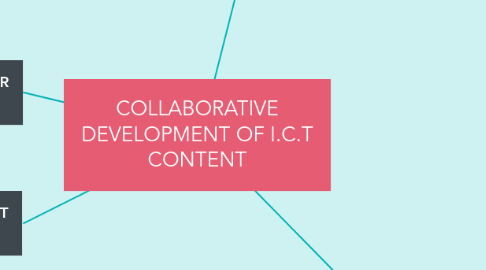
1. PROJECT MANAGEMENT FOR I.C.T CONTENT
1.1. "Project management is “the application of knowledge, skills, tools and techniques to project activities to meet project requirements”
1.1.1. Scope Management
1.1.2. Time Management
1.1.3. Cost Management
1.1.4. Quality Management
2. CURATING EXISTING CONTENT FOR THE USE ON THE WEB
3. TEAM STRUCTURE
3.1. Director I.C.T
3.1.1. The I.C.T Director is responsible for managing the communications, workstations and servers of the school computer network. He/She makes sure all software is licensed and updated to meet the needs of the school. Remote Desktop. Manage and maintain the School website using industry standard website technologies.
3.2. Network team
3.2.1. Network team are responsible for implementing, maintaining, supporting, developing and, in some cases, designing communication networks within an organisation or between organisations. Their goal is to ensure the integrity of high availability network infrastructure to provide maximum performance for their users.
3.2.1.1. INFORMATION SYSTEM GROUP
3.2.1.2. SYSTEMS AND SERVER TEAM
3.2.1.3. DESKTOP AND MEDIA SERVICES TEAM
3.2.1.4. DYNAMIC INFORMATION SOURCES
3.2.1.5. TELECOMM TEAM
4. ONLINE COLLABORATIVE TOOLS AND PROCESSES
4.1. 'Collaboration tools' is a catchall term used for different types of software and online services that allow people to work together on common projects, regardless of their physical location. It can be something as simple as email and as complex as sophisticated project management software. Online collaboration tools are web-based applications that offer basic services such as instant messaging for groups, mechanisms for file sharing and collaborative search engines (CSE) to find information distributed within the system of the organization, community or team.
4.1.1. Communicate with your team
4.1.1.1. Flowdock
4.1.1.1.1. is a group and private chat platform. Its most interesting feature is its team inbox which aggregates notifications from other channels, like Twitter, Asana and customer support tools.
4.1.1.2. GoToMeeting
4.1.1.2.1. is an online video conferencing software that allows users to schedule meetings and share screens. It’s one of the most popular video tools with millions of users.
4.1.1.3. Slack
4.1.1.3.1. is a popular and well-crafted platform offering instant messaging, file transfers and powerful message search. It has many features and dozens of integrations with other tools like Trello and Intercom.
4.1.1.4. WebEx
4.1.1.4.1. provides personalized video meeting rooms where users can to host and join meetings. People can use WebEx for team collaboration, webinars, training and customer support.
4.1.2. Manage projects and tasks
4.1.2.1. Asana
4.1.2.1.1. One of the most well-known project management tools, Asana allows users to assign tasks to other members, add followers to projects and monitor deadlines. It’s very useful as a to-do list or calendar for strategic planning.
4.1.2.2. Dapulse
4.1.2.2.1. is a collaboration tool that helps you communicate, set objectives and assign tasks. Its big advantage: it has a great visual design so it’s easy to understand and work with.
4.1.2.3. ProofHub
4.1.2.3.1. is a work management tool that offers a comprehensive suite of collaboration and project management functions. On this platform, you can organize files, plan and monitor projects and discuss with colleagues and stakeholders. ProofHub also lets you review and approve files through an online proofing tool.
4.1.2.4. Trello
4.1.2.4.1. has an intriguing interface that resembles solitaire (you can even drag task cards across columns, just like you would playing cards). It’s easy to learn and works well for monitoring projects and assigning tasks. Trello also makes using Agile, Scrum and other project management frameworks easy.
4.1.2.5. Redbooth
4.1.2.5.1. is an easy-to-use project management tool. Its platform allows users to plan and collaborate through many functions from video conferencing to creating Gantt charts.
4.1.2.6. Wimi
4.1.2.6.1. offers users their own ‘unified workspaces’ where teams can manage projects and share files and calendars. You can control access in each workspace with a rights-based system. Wimi Drive, their file syncing software, helps you make the most out of cloud technology.
4.1.3. Create together
4.1.3.1. Codingteam
4.1.3.1.1. Coders can easily collaborate when writing their code through platforms like Codingteam. It offers a free ‘software forge’ that encourages visibility and collective code building.
4.1.3.2. Igloo
4.1.3.2.1. is a company intranet that allows people to communicate and get work done. Its wiki allows colleagues to share information and ideas.
4.1.3.3. Google Docs
4.1.3.3.1. Google needs no introduction. Google;s collaboration tools include its Docs and Sheets services, which are designed to allow teams to edit files at the same time and save all their changes automatically.
4.1.3.4. Quip
4.1.3.4.1. started off as a mobile app and released a desktop version later. Teams can import and work live on different file types. Edits are saved automatically and its chat, comment and checklist features make collaboration easy.

